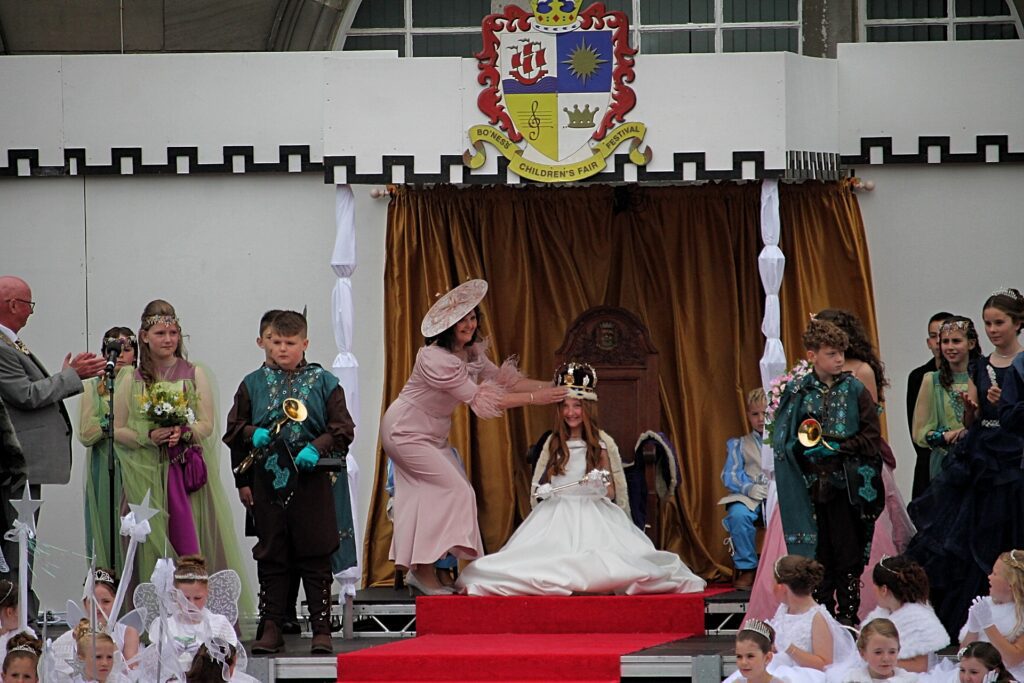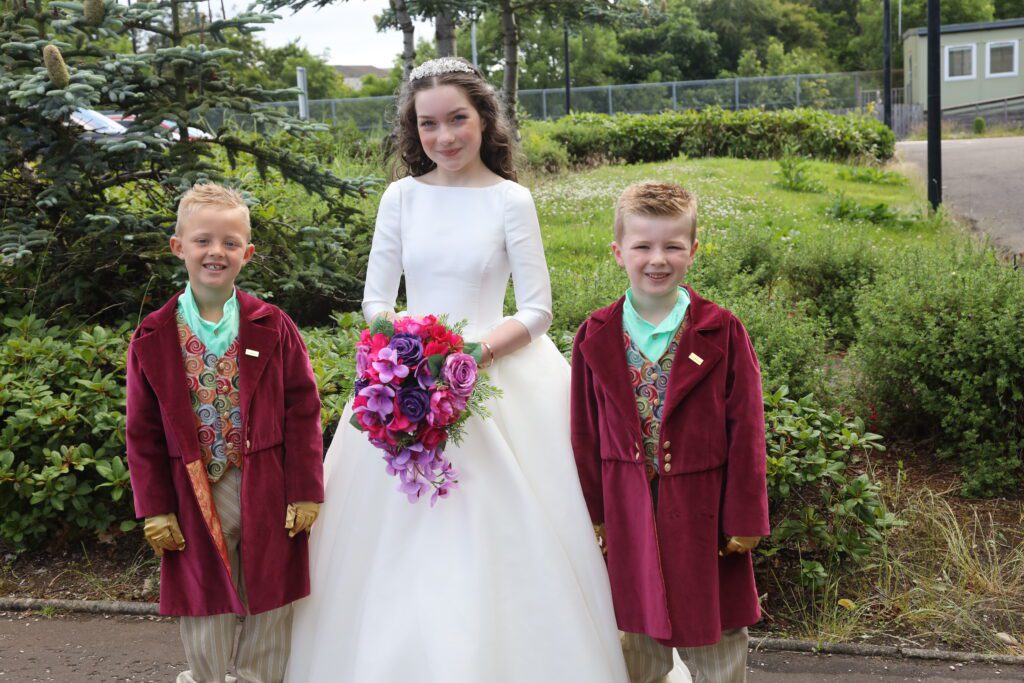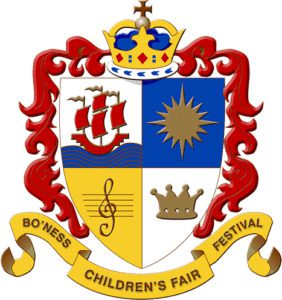“Hail Smiling Morn”
When asked to pen my memories of my involvement in The Fair, I was a bit reluctant. Where to begin? Then the line from a song came to me “start at the very beginning.”
Of course, I had attended the Fair with my parents, but like all children, the real experience of being part of the Fair begins when you start school. In the late summer of 1932 when I was enrolled at Carriden School, the excitement of the Fair was over and only again started to bubble up after Easter the following year when Margaret McMahon of Borrowstoun School was chosen as Queen.
That early memory was of a long day which began by teachers assembling the pupils and walking from Carriden School up to the Grange School where we joined the boys and girls of the Grange to line up and walk behind Carriden Band playing “Hail Smiling Morn” as we made our way from the Grange School playground, along Grange Terrace to the Glebe Park.
When the music for the first of the Fair Songs struck up, my eyes were on the wee man waving his baton. Along all the other children I was remembering to count to eight as he had instructed us on his visits to the school in previous weeks when we practised singing “See the Summer Sun is Gleaming” and “Hail to our Queen”. The conductor at that time was “Wee Band Sandy”. Ceremony over, the schools joined the procession to the Ladywell Park at Kinneil House where the Revels were held (the last year at this location).
The following year saw Helen Young from Kinneil School crowned as Queen and as we gathered in the Grange School that morning, there was a lot of excited chatter, especially among the girls, saying “It’s the Grange next year!”
My next notable memory was 1935 By this time Carriden School had closed and I was now a pupil of Grange School and Fair fever was breaking out! I discovered what had been meant by “It’s the Grange next year!” In 1935the Grange was the Queen’s School and Andrea Walker of Cowdenhill Road was chosen as Queen. Her Champion was John Paul from Stacks Farm – John is an active nonagenarian still living locally and when we meet one another as we do our shopping, we enjoy a chat. I was of an age where I enjoyed the excitement of the weeks leading to the Fair Day and on the Day itself, the crowd, the spectacle and the music.
The Second World War meant that the Fair did not take place and during this time I left school and started work as an apprentice joiner with Jas. Braes & Son. Throughout the time of the war, from the month of June to mid-July, Mr Braes Sen. (Founder of the business), would tell me what would have been taking place regarding the Fair preparations.
At last the great day came, the War was over! While the whole country celebrated this event, Bo’ness folk were also celebrating the fact that this would mean the return of Bo’ness Children’s Fair Festival as highlight of the local year!
In 1946 the Grange School provided the Retinue and honour and celebration once more came to Cowdenhill when Sadie Potter was chosen as Queen.
Back then, the date of the Fair was the Friday which signalled the start of the Glasgow Fair and the many factories and businesses in the town had the Glasgow Fair fortnight as their summer trades holidays. The Fair Day was the start of two weeks leisure for those in work and the beginning of the long summer holidays for the school children.
Several local businesses were involved in the preparations for the Fair.
Thomas Cuthell and Sons would look out the flags which they would put in place along the route of the Fair procession, while John White Undertakers who dressed the main platform would be checking fabric, ribbons and ropes to turn a bare wooden platform into an area fit for a Queen and her Court.
At the beginning of July it was hustle and bustle at the Braes Joiner Shop. The main platform bearers and boards, School signs etc. were brought out from the storage shed, brushed down, cleaned, checked over and repainted as necessary. Priority was given to the main platform and another which was situated at the Hall-keeper’s door for the band. The platforms for the Fair Revels needed the same checks and maintenance. Journeymen and apprentices had no time to spare – a lot of work had to be done in a short time.
A sizeable lorry was needed to transport all the materials and on the Fair Monday a lorry from Stewart of the Drum Farm reversed into the yard and loaded up ready to deliver to the Glebe Park on the Tuesday when work was started.
There was work to do inside the Town Hall too. A set of stairs had to be set up in the main Hall to allow access to the stage where the crowning would be held in the case of inclement weather. Up in the Auditorium preparation work was done in readiness for the removal of a window at the balcony on the Fair morning, with a small set of steps to be put in place to give Commentator and some guests access to the balcony.
The Fair Wednesday and Thursday saw the erection of the platforms for the revels after the procession. In 1946 and for a few years after, the revels were held in the Academy Playing Field off Grahamsdyke Road. Two platforms were needed, one for the Band and one for the tap dancers and Punch and Judy etc.
Come the Fair morning, while town’s folk decked themselves out in their finery for the Fair, the lads from the joiners’ shop were dressed in fresh clean dungarees with an open necked dress shirt instead of the usual working shirt. It was an early start on the Fair Day as first thing on the Fair morning one of the last jobs which had to be done was lining the Glebe Park with sawdust to mark the areas allocated for the various schools, then signs for the Schools were fixed in place and final checks made on platforms before John White and his men dressed the platform. There was an occasion when overnight rain meant the seating area for fairies and flower girls was very wet. As some folk mopped up, others quickly made a trip down the town to fetch back a supply of old newspapers which were put in place then covered with the fabric to provide dry seating. All was ready as the park started to fill with the crowds arriving for the ceremony.
As a pupil I had never had a main part in the Fair and as an apprentice, I missed out on an important task too. The job of running up the Royal Standard on the flag pole as the Queen is crowned was always given to the youngest apprentice and by 1946, though still apprentice, I was not the youngest!
Crowning ceremony over, as the Glebe Park emptied the joiner squad quickly jumped into action. The window had to be replaced at the Auditorium ready for evening festivities, the crowning and band platforms stripped, dismantled, loaded onto the lorry and back to the yard and Mrs Braes’ house for a well-earned lunch of steak pie with all the usual accompaniments followed by trifle. The lorry still had to be unloaded, not a joyful task on a full stomach.
Afternoon revels over, it was up to the Park to remove the two platforms and re-erect them at the Town Hall for an outdoor evening concert. Of course, they had to be removed about 8.30pm to give access to the folk arriving for the Late Night Fair Dance. Quite a hectic, long day.
As with everything in this world, things change. The Revels moved to the Douglas Park and changes in the entertainment programme meant there was no longer need to remove and re-erect platforms for an evening concert. Bo’ness became part of Falkirk District the dates of the school terms changed bringing about a change in the date of the Fair which was now in the charge of a local Committee. Fresh thinking brought new ideas and improvements -tubular scaffolding replaced timber with a new set-up including a lower lever extension to the platform where the presentees from the schools perform their dance routine and side stands brought in to provide raised seating accommodation for guests.
By this time I had moved to other employment and as a manager permitted staff to be on the premises after hours while materials were assembled and work begun on decorations for the Company lorry and at the same time having to strike a balance between making sure deliveries to customers were met and allowing off-road time on the Fair E’en for the lorry to be decorated and ready for the Fair procession.
Happily the Fair continues. Health and Safety means that arches no longer span the roads, instead there are magnificent house frontages and beautiful small archways. Children no longer sit on decorated vehicles. In this respect things have come full circle with the children walking the route of the procession. The excitement, the crowds, the bands and the spectacle are all still there.Truth to tell it’s years since I viewed the crowning ceremony. Now I sit in my garden with a “wee something” and listen to it all coming up on the air from the Glebe Park then strolling up to the top of the road to cheer the passing procession.
A successful Fair Day is the result of a lot of hard work over weeks and months by many volunteers. This year, seventy years on from my first working Fair, the Grange School again provides the retinue. To the Queen, her Court and all taking part in the Fair, enjoy every minute of your day, store up the memories. Memories are great!
John H. McLeod






